oil filter SKODA OCTAVIA 2009 2.G / (1Z) Owner's Manual
[x] Cancel search | Manufacturer: SKODA, Model Year: 2009, Model line: OCTAVIA, Model: SKODA OCTAVIA 2009 2.G / (1Z)Pages: 304, PDF Size: 19.56 MB
Page 5 of 304
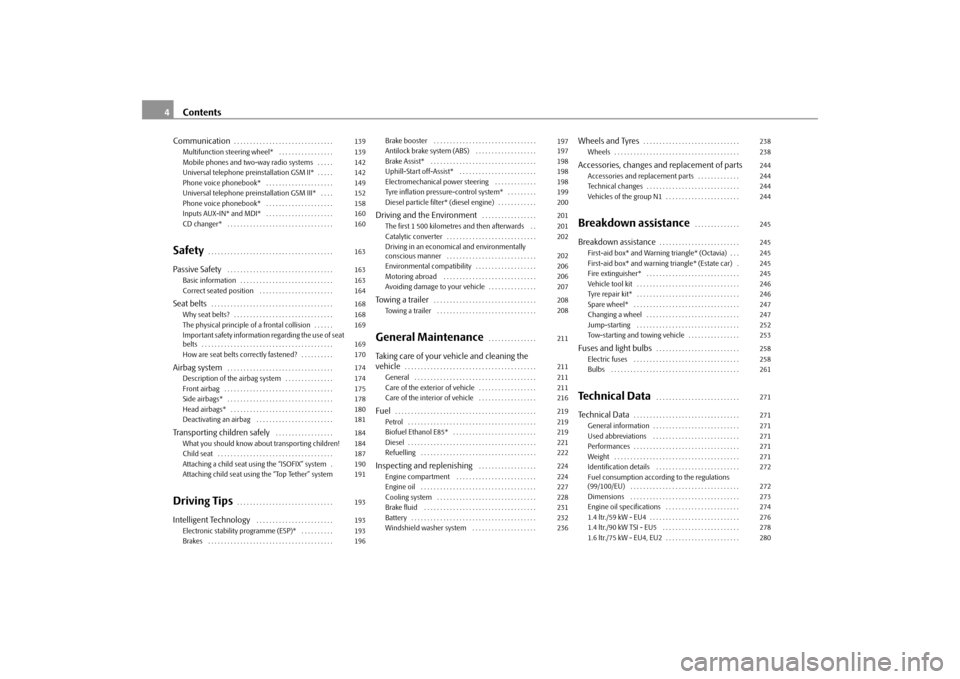
Contents 4Communication
. . . . . . . . . . . . . . . . . . . . . . . . . . . . . . .
Multifunction steering wheel* . . . . . . . . . . . . . . . . .
Mobile phones and two-way radio systems . . . . .
Universal telephone preinstallation GSM II* . . . . .
Phone voice phonebook* . . . . . . . . . . . . . . . . . . . . .
Universal telephone preinstallation GSM III* . . . .
Phone voice phonebook* . . . . . . . . . . . . . . . . . . . . .
Inputs AUX-IN* and MDI* . . . . . . . . . . . . . . . . . . . . .
CD changer* . . . . . . . . . . . . . . . . . . . . . . . . . . . . . . . . .
Safety
. . . . . . . . . . . . . . . . . . . . . . . . . . . . . . . . . . . . . . .
Passive Safety
. . . . . . . . . . . . . . . . . . . . . . . . . . . . . . . . .
Basic information . . . . . . . . . . . . . . . . . . . . . . . . . . . . .
Correct seated position . . . . . . . . . . . . . . . . . . . . . . .
Seat belts
. . . . . . . . . . . . . . . . . . . . . . . . . . . . . . . . . . . . . .
Why seat belts? . . . . . . . . . . . . . . . . . . . . . . . . . . . . . . .
The physical principle of a frontal collision . . . . . .
Important safety information regarding the use of seat
belts . . . . . . . . . . . . . . . . . . . . . . . . . . . . . . . . . . . . . . . . .
How are seat belts correctly fastened? . . . . . . . . . .
Airbag system
. . . . . . . . . . . . . . . . . . . . . . . . . . . . . . . . .
Description of the airbag system . . . . . . . . . . . . . . .
Front airbag . . . . . . . . . . . . . . . . . . . . . . . . . . . . . . . . . .
Side airbags* . . . . . . . . . . . . . . . . . . . . . . . . . . . . . . . . .
Head airbags* . . . . . . . . . . . . . . . . . . . . . . . . . . . . . . . .
Deactivating an airbag . . . . . . . . . . . . . . . . . . . . . . . .
Transporting children safely
. . . . . . . . . . . . . . . . . .
What you should know about transporting children!
Child seat . . . . . . . . . . . . . . . . . . . . . . . . . . . . . . . . . . . .
Attaching a child seat using the “ISOFIX” system .
Attaching child seat using the “Top Tether” system
Driving Tips
. . . . . . . . . . . . . . . . . . . . . . . . . . . . . .
Intelligent Technology
. . . . . . . . . . . . . . . . . . . . . . . .
Electronic stability programme (ESP)* . . . . . . . . . .
Brakes . . . . . . . . . . . . . . . . . . . . . . . . . . . . . . . . . . . . . . . Brake booster . . . . . . . . . . . . . . . . . . . . . . . . . . . . . . . .
Antilock brake system (ABS) . . . . . . . . . . . . . . . . . . .
Brake Assist* . . . . . . . . . . . . . . . . . . . . . . . . . . . . . . . . .
Uphill-Start off-Assist* . . . . . . . . . . . . . . . . . . . . . . . .
Electromechanical power steering . . . . . . . . . . . . .
Tyre inflation pressure-control system* . . . . . . . . .
Diesel particle filter* (diesel engine) . . . . . . . . . . . .
Driving and the Environment
. . . . . . . . . . . . . . . . .
The first 1 500 kilometres and then afterwards . .
Catalytic converter . . . . . . . . . . . . . . . . . . . . . . . . . . . .
Driving in an economical and environmentally
conscious manner . . . . . . . . . . . . . . . . . . . . . . . . . . . .
Environmental compatibility . . . . . . . . . . . . . . . . . . .
Motoring abroad . . . . . . . . . . . . . . . . . . . . . . . . . . . . .
Avoiding damage to your vehicle . . . . . . . . . . . . . . .
Towing a trailer
. . . . . . . . . . . . . . . . . . . . . . . . . . . . . . . .
Towing a trailer . . . . . . . . . . . . . . . . . . . . . . . . . . . . . . .
General Maintenance
. . . . . . . . . . . . . . .
Taking care of your vehicle and cleaning the
vehicle
. . . . . . . . . . . . . . . . . . . . . . . . . . . . . . . . . . . . . . . . .
General . . . . . . . . . . . . . . . . . . . . . . . . . . . . . . . . . . . . . .
Care of the exterior of vehicle . . . . . . . . . . . . . . . . . .
Care of the interior of vehicle . . . . . . . . . . . . . . . . . .
Fuel
. . . . . . . . . . . . . . . . . . . . . . . . . . . . . . . . . . . . . . . . . . . .
Petrol . . . . . . . . . . . . . . . . . . . . . . . . . . . . . . . . . . . . . . . .
Biofuel Ethanol E85* . . . . . . . . . . . . . . . . . . . . . . . . . .
Diesel . . . . . . . . . . . . . . . . . . . . . . . . . . . . . . . . . . . . . . . .
Refuelling . . . . . . . . . . . . . . . . . . . . . . . . . . . . . . . . . . . .
Inspecting and replenishing
. . . . . . . . . . . . . . . . . .
Engine compartment . . . . . . . . . . . . . . . . . . . . . . . . .
Engine oil . . . . . . . . . . . . . . . . . . . . . . . . . . . . . . . . . . . .
Cooling system . . . . . . . . . . . . . . . . . . . . . . . . . . . . . . .
Brake fluid . . . . . . . . . . . . . . . . . . . . . . . . . . . . . . . . . . .
Battery . . . . . . . . . . . . . . . . . . . . . . . . . . . . . . . . . . . . . . .
Windshield washer system . . . . . . . . . . . . . . . . . . . .
Wheels and Tyres
. . . . . . . . . . . . . . . . . . . . . . . . . . . . . .
Wheels . . . . . . . . . . . . . . . . . . . . . . . . . . . . . . . . . . . . . . .
Accessories, changes and replacement of partsAccessories and replacement parts . . . . . . . . . . . . .
Technical changes . . . . . . . . . . . . . . . . . . . . . . . . . . . . .
Vehicles of the group N1 . . . . . . . . . . . . . . . . . . . . . . .Breakdown assistance
. . . . . . . . . . . . . .
Breakdown assistance
. . . . . . . . . . . . . . . . . . . . . . . . .
First-aid box* and Warning triangle* (Octavia) . . .
First-aid box* and warning triangle* (Estate car) .
Fire extinguisher* . . . . . . . . . . . . . . . . . . . . . . . . . . . . .
Vehicle tool kit . . . . . . . . . . . . . . . . . . . . . . . . . . . . . . . .
Tyre repair kit* . . . . . . . . . . . . . . . . . . . . . . . . . . . . . . . .
Spare wheel* . . . . . . . . . . . . . . . . . . . . . . . . . . . . . . . . .
Changing a wheel . . . . . . . . . . . . . . . . . . . . . . . . . . . . .
Jump-starting . . . . . . . . . . . . . . . . . . . . . . . . . . . . . . . .
Tow-starting and towing vehicle . . . . . . . . . . . . . . . .
Fuses and light bulbs
. . . . . . . . . . . . . . . . . . . . . . . . . .
Electric fuses . . . . . . . . . . . . . . . . . . . . . . . . . . . . . . . . .
Bulbs . . . . . . . . . . . . . . . . . . . . . . . . . . . . . . . . . . . . . . . .
Technical Data
. . . . . . . . . . . . . . . . . . . . . . . . . .
Technical Data
. . . . . . . . . . . . . . . . . . . . . . . . . . . . . . . . .
General information . . . . . . . . . . . . . . . . . . . . . . . . . . .
Used abbreviations . . . . . . . . . . . . . . . . . . . . . . . . . . .
Performances . . . . . . . . . . . . . . . . . . . . . . . . . . . . . . . . .
Weight . . . . . . . . . . . . . . . . . . . . . . . . . . . . . . . . . . . . . . .
Identification details . . . . . . . . . . . . . . . . . . . . . . . . . .
Fuel consumption according to the regulations
(99/100/EU) . . . . . . . . . . . . . . . . . . . . . . . . . . . . . . . . . .
Dimensions . . . . . . . . . . . . . . . . . . . . . . . . . . . . . . . . . .
Engine oil specifications . . . . . . . . . . . . . . . . . . . . . . .
1.4 ltr./59 kW - EU4 . . . . . . . . . . . . . . . . . . . . . . . . . . . .
1.4 ltr./90 kW TSI - EU5 . . . . . . . . . . . . . . . . . . . . . . . .
1.6 ltr./75 kW - EU4, EU2 . . . . . . . . . . . . . . . . . . . . . . . 139
139
142
142
149
152
158
160
160
163
163
163
164
168
168
169
169
170
174
174
175
178
180
181
184
184
187
190
191
193
193
193
196197
197
198
198
198
199
200
201
201
202
202
206
206
207
208
208
211
211
211
211
216
219
219
219
221
222
224
224
227
228
231
232
236238
238
244
244
244
244
245
245
245
245
245
246
246
247
247
252
253
258
258
261
271
271
271
271
271
271
272
272
273
274
276
278
280
se0.1.book Page 4 Friday, April 10, 2009 3:19 PM
Page 33 of 304
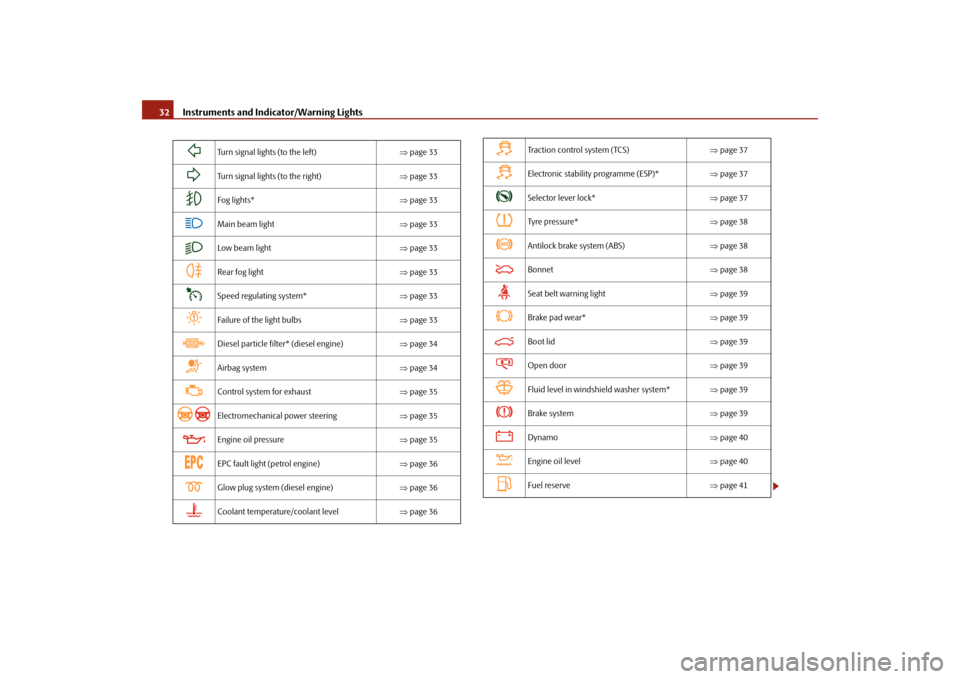
Instruments and Indicator/Warning Lights
32
Turn signal lights (to the left)
⇒page 33
Turn signal lights (to the right)
⇒page 33
Fog lights*
⇒page 33
Main beam light
⇒page 33
Low beam light
⇒page 33
Rear fog light
⇒page 33
Speed regulating system*
⇒page 33
Failure of the light bulbs
⇒page 33
Diesel particle filter* (diesel engine)
⇒page 34
Airbag system
⇒page 34
Control system for exhaust
⇒page 35
Electromechanical power steering
⇒page 35
Engine oil pressure
⇒page 35
EPC fault light (petrol engine)
⇒page 36
Glow plug system (diesel engine)
⇒page 36
Coolant temperature/coolant level
⇒page 36
Traction control system (TCS)
⇒page 37
Electronic stability programme (ESP)*
⇒page 37
Selector lever lock*
⇒page 37
Tyre pressure*
⇒page 38
Antilock brake system (ABS)
⇒page 38
Bonnet
⇒page 38
Seat belt warning light
⇒page 39
Brake pad wear*
⇒page 39
Boot lid
⇒page 39
Open door
⇒page 39
Fluid level in windshield washer system*
⇒page 39
Brake system
⇒page 39
Dynamo
⇒page 40
Engine oil level
⇒page 40
Fuel reserve
⇒page 41
se0.1.book Page 32 Friday, April 10, 2009 3:19 PM
Page 213 of 304
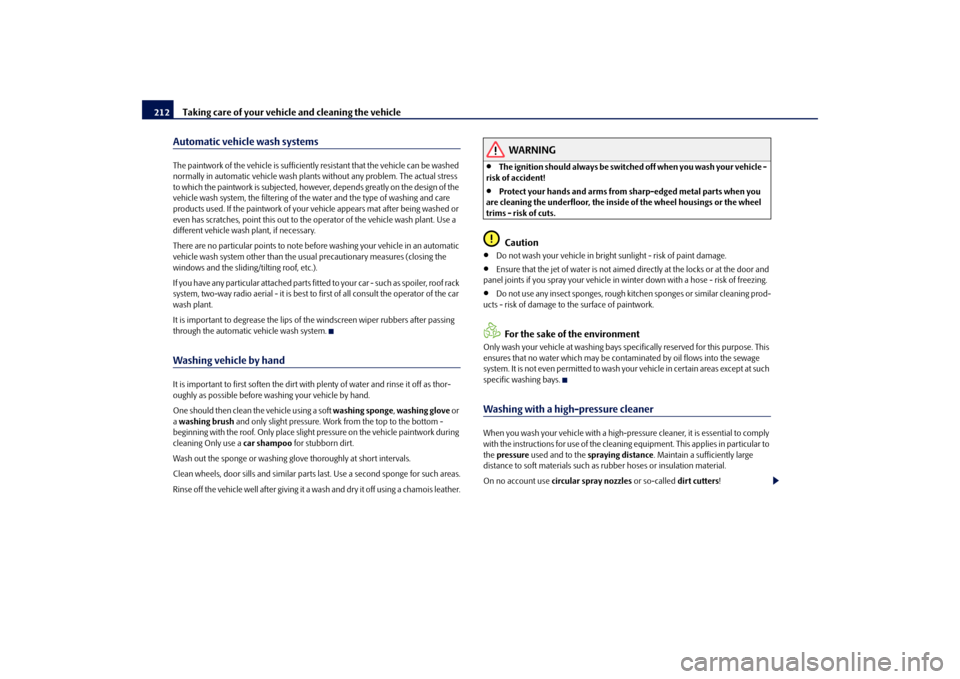
Taking care of your vehicle and cleaning the vehicle
212
Automatic vehicle wash systemsThe paintwork of the vehicle is sufficiently resistant that the vehicle can be washed normally in automatic vehicle wash plants without any problem. The actual stress to which the paintwork is subjected, however, depends greatly on the design of the vehicle wash system, the filtering of the water and the type of washing and care products used. If the paintwork of your
vehicle appears mat after being washed or
even has scratches, point this out to the operator of the vehicle wash plant. Use a different vehicle wash plant, if necessary. There are no particular points to note be
fore washing your vehicle in an automatic
vehicle wash system other than the usua
l precautionary measures (closing the
windows and the sliding/tilting roof, etc.). If you have any particular atta
ch e d p a r t s f i t te d t o y o u r c a r - s u ch a s s p o i l e r, ro o f ra ck
system, two-way radio aerial - it is best to
first of all consult the operator of the car
wash plant. It is important to degrease the lips of
the windscreen wiper rubbers after passing
through the automatic vehicle wash system.Washing vehicle by handIt is important to first soften the dirt with
plenty of water and
rinse it off as thor-
oughly as possible before wa
shing your vehi
cle by hand.
One should then clean the vehicle using a soft
washing sponge
, washing glove
or
a washing brush
and only slight pressure. Work
from the top to the bottom -
beginning with the roof. Only place slight
pressure on the vehicle paintwork during
cleaning Only use a
car shampoo
for stubborn dirt.
Wash out the sponge or washing glove thoroughly at short intervals.Clean wheels, door sills and similar parts
last. Use a second sponge for such areas.
Rinse off the vehicle well after giving it a
wash and dry it off using a chamois leather.
WARNING
•
The ignition should always be switched off when you wash your vehicle -
risk of accident!•
Protect your hands and arms from sharp-edged metal parts when you
are cleaning the underfloor, the inside
of the wheel housings or the wheel
trims - risk of cuts.
Caution
•
Do not wash your vehicle in bright
sunlight - risk of paint damage.
•
Ensure that the jet of water is not aimed directly at the locks or at the door and
panel joints if you spray your
vehicle in winter down with
a hose - risk of freezing.
•
Do not use any insect sponges, rough ki
tchen sponges or simi
lar cleaning prod-
ucts - risk of damage to the surface of paintwork.
For the sake of the environment
Only wash your vehicle at washing bays specifically reserved for this purpose. This ensures that no water which may be cont
aminated by oil flow
s into the sewage
system. It is not even permitted to wash your vehicle in certain areas except at such specific washing bays.Washing with a high-pressure cleanerWhen you wash your vehicle with a high-pre
ssure cleaner, it is
essential to comply
with the instructions for use of the cleaning equipment. This applies in particular to the
pressure
used and to the
spraying distance
. Maintain a sufficiently large
distance to soft materials such as
rubber hoses or insulation material.
On no account use
circular spray nozzles
or so-called
dirt cutters
!
se0.1.book Page 212 Frida
y, April 10, 2009 3:19 PM
Page 229 of 304
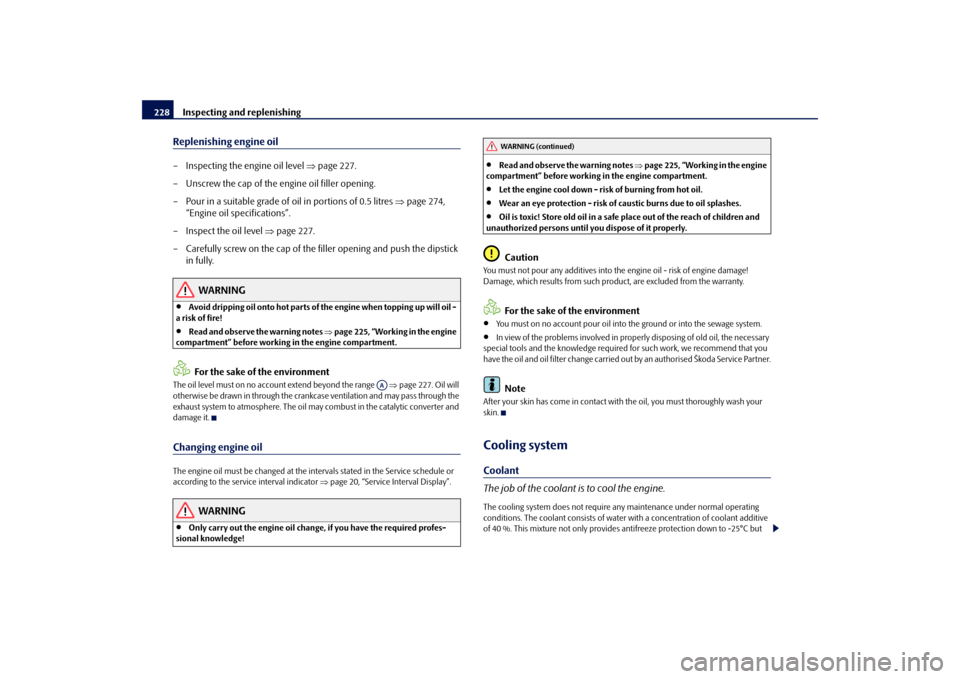
Inspecting and replenishing
228
Replenishing engine oil– Inspecting the engine oil level
⇒
page 227.
– Unscrew the cap of the engine oil filler opening. – Pour in a suitable grade of oil in portions of 0.5 litres
⇒
page 274,
“Engine oil specifications”.
– Inspect the oil level
⇒
page 227.
– Carefully screw on the cap of the
filler opening and push the dipstick
in fully.
WARNING
•
Avoid dripping oil onto hot parts of the engine when topping up will oil -
a risk of fire!•
Read and observe the warning notes
⇒page 225, “Working in the engine
compartment” before working in the engine compartment.
For the sake of the environment
The oil level must on no account extend beyond the range
⇒page 227. Oil will
otherwise be drawn in through the crankc
ase ventilation and may pass through the
exhaust system to atmosphere. The oil ma
y combust in the cata
lytic converter and
damage it.Changing engine oilThe engine oil must be changed at the intervals stated in the Service schedule or according to the service interval indicator
⇒page 20, “Service Interval Display”.
WARNING
•
Only carry out the engine oil change, if you have the required profes-
sional knowledge!
•
Read and observe the warning notes
⇒page 225, “Working in the engine
compartment” before working in the engine compartment.•
Let the engine cool down - risk of burning from hot oil.
•
Wear an eye protection - risk of caustic burns due to oil splashes.
•
Oil is toxic! Store old oil in a safe place out of the reach of children and
unauthorized persons until you dispose of it properly.
Caution
You must not pour any additives into th
e engine oil - risk of engine damage!
Damage, which results from such produc
t, are excluded from the warranty.
For the sake of the environment
•
You must on no account pour oil into
the ground or into the sewage system.
•
In view of the problems involved in prop
erly disposing of old oil, the necessary
special tools and the knowledge required for such work, we recommend that you have the oil and oil filter change carried out by an authorised Škoda Service Partner.
Note
After your skin has come in contact with the oil, you must thoroughly wash your skin.Cooling systemCoolant The job of the coolant is to cool the engine.The cooling system does not require an
y maintenance under normal operating
conditions. The coolant consis
ts of water with a concentration of coolant additive
of 40 %. This mixture not only provides
antifreeze protection down to -25°C but
AA
WARNING (continued)
se0.1.book Page 228 Frida
y, April 10, 2009 3:19 PM
Page 278 of 304
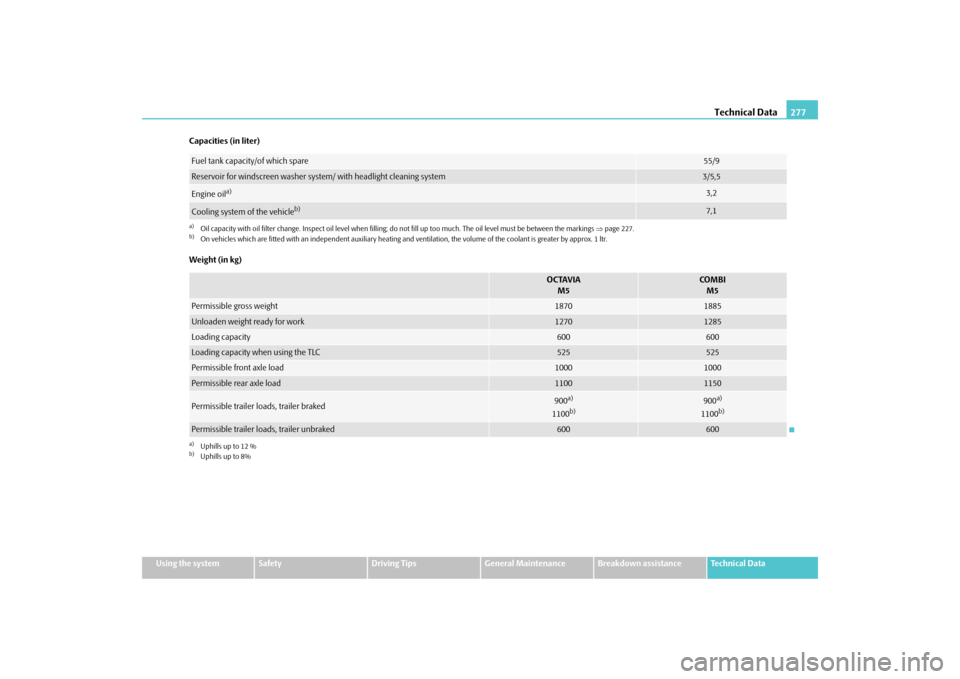
Technical Data
277
Using the system
Safety
Driving Tips
General Maintenance
Breakdown assistance
Technical Data
Capacities (in liter) Weight (in kg)Fuel tank capacity/of which spare
55/9
Reservoir for windscreen washer system/ with headlight cleaning system
3/5,5
Engine oil
a)
a)Oil capacity with oil filter change. Inspect oil level when fi
lling; do not fill up too much. The oil level must be between the
markings
⇒page 227.
3,2
Cooling system of the vehicle
b)
b)On vehicles which are fitted with an indepe
ndent auxiliary heating and ventilation, the
volume of the coolant is greater by app
rox. 1 ltr.
7,1
OCTAVIA M5
COMBIM5
Permissible gross weight
1870
1885
Unloaden weight ready for work
1270
1285
Loading capacity
600
600
Loading capacity when using the TLC
525
525
Permissible front axle load
1000
1000
Permissible rear axle load
1100
1150
Permissible trailer loads, trailer braked
900
a)
1100
b)
a)Uphills up to 12 %b)Uphills up to 8%
900
a)
1100
b)
Permissible trailer loads, trailer unbraked
600
600
se0.1.book Page 277 Frida
y, April 10, 2009 3:19 PM
Page 280 of 304
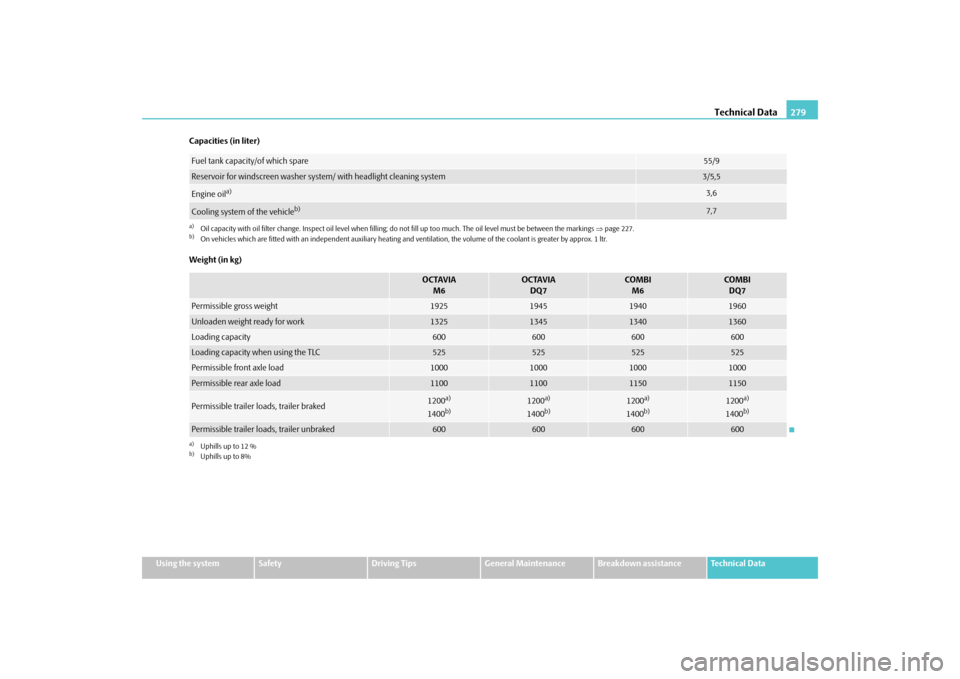
Technical Data
279
Using the system
Safety
Driving Tips
General Maintenance
Breakdown assistance
Technical Data
Capacities (in liter) Weight (in kg)Fuel tank capacity/of which spare
55/9
Reservoir for windscreen washer system/ with headlight cleaning system
3/5,5
Engine oil
a)
a)Oil capacity with oil filter change. Inspect oil level when fi
lling; do not fill up too much. The oil level must be between the
markings
⇒page 227.
3,6
Cooling system of the vehicle
b)
b)On vehicles which are fitted with an indepe
ndent auxiliary heating and ventilation, the
volume of the coolant is greater by app
rox. 1 ltr.
7,7
OCTAVIA M6
OCTAVIADQ7
COM B I M6
COMBIDQ7
Permissible gross weight
1925
1945
1940
1960
Unloaden weight ready for work
1325
1345
1340
1360
Loading capacity
600
600
600
600
Loading capacity when using the TLC
525
525
525
525
Permissible front axle load
1000
1000
1000
1000
Permissible rear axle load
1100
1100
1150
1150
Permissible trailer loads, trailer braked
1200
a)
1400
b)
a)Uphills up to 12 %b)Uphills up to 8%
1200
a)
1400
b)
1200
a)
1400
b)
1200
a)
1400
b)
Permissible trailer loads, trailer unbraked
600
600
600
600
se0.1.book Page 279 Frida
y, April 10, 2009 3:19 PM
Page 282 of 304
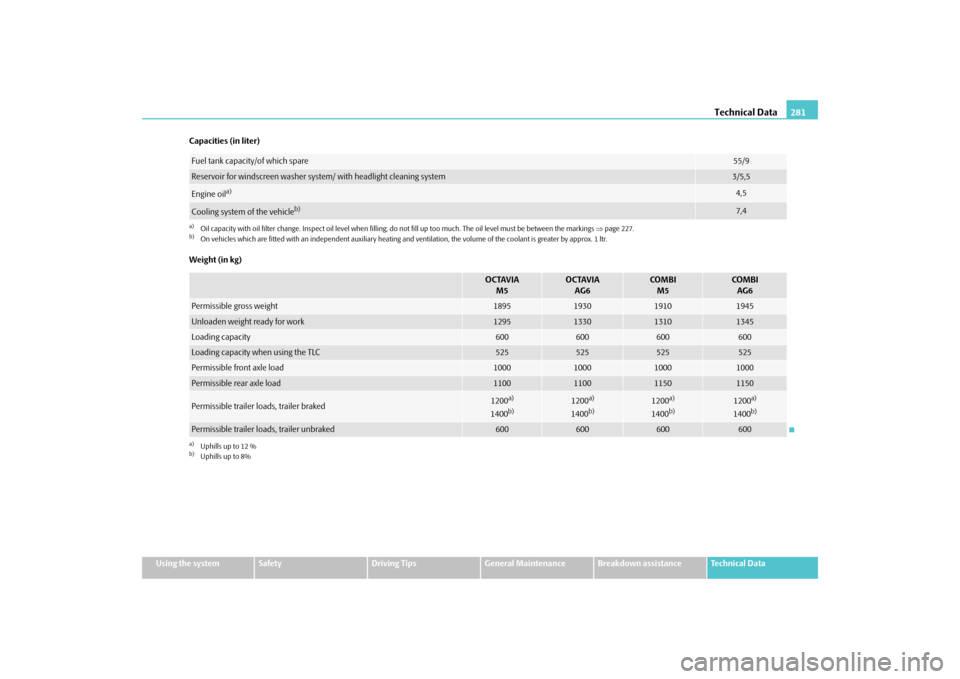
Technical Data
281
Using the system
Safety
Driving Tips
General Maintenance
Breakdown assistance
Technical Data
Capacities (in liter) Weight (in kg)Fuel tank capacity/of which spare
55/9
Reservoir for windscreen washer system/ with headlight cleaning system
3/5,5
Engine oil
a)
a)Oil capacity with oil filter change. Inspect oil level when fi
lling; do not fill up too much. The oil level must be between the
markings
⇒page 227.
4,5
Cooling system of the vehicle
b)
b)On vehicles which are fitted with an indepe
ndent auxiliary heating and ventilation, the
volume of the coolant is greater by app
rox. 1 ltr.
7,4
OCTAVIA M5
OCTAVIAAG6
COMBIM5
COMBIAG6
Permissible gross weight
1895
1930
1910
1945
Unloaden weight ready for work
1295
1330
1310
1345
Loading capacity
600
600
600
600
Loading capacity when using the TLC
525
525
525
525
Permissible front axle load
1000
1000
1000
1000
Permissible rear axle load
1100
1100
1150
1150
Permissible trailer loads, trailer braked
1200
a)
1400
b)
a)Uphills up to 12 %b)Uphills up to 8%
1200
a)
1400
b)
1200
a)
1400
b)
1200
a)
1400
b)
Permissible trailer loads, trailer unbraked
600
600
600
600
se0.1.book Page 281 Frida
y, April 10, 2009 3:19 PM
Page 284 of 304
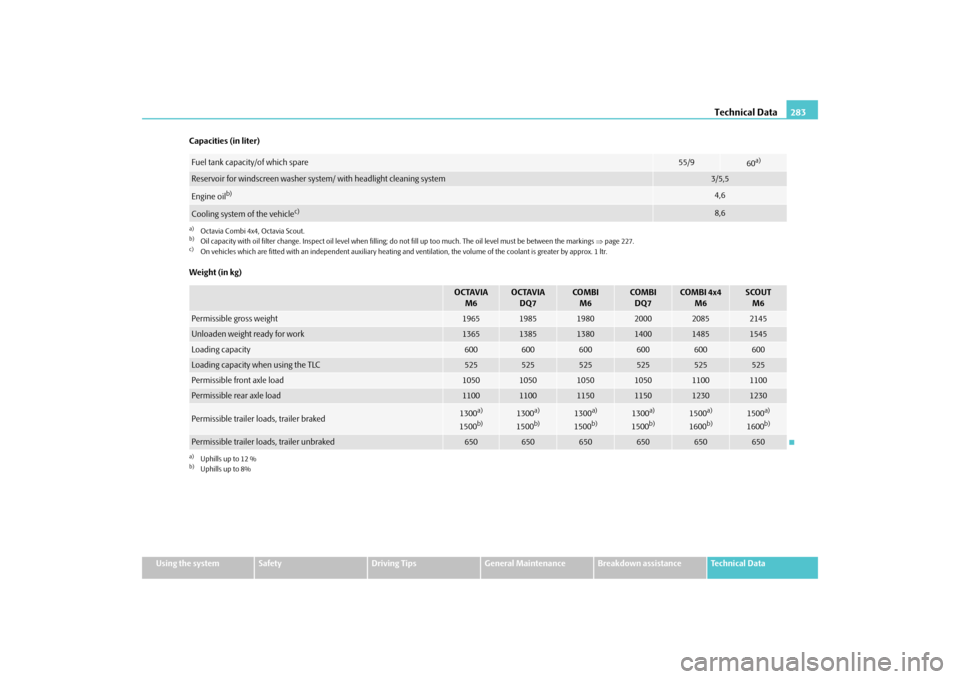
Technical Data
283
Using the system
Safety
Driving Tips
General Maintenance
Breakdown assistance
Technical Data
Capacities (in liter) Weight (in kg)Fuel tank capacity/of which spare
55/9
60a)
a)Octavia Combi 4x4, Octavia Scout.Reservoir for windscreen washer system/ with headlight cleaning system
3/5,5
Engine oil
b)
b)Oil capacity with oil filter change. Inspect oil level when fi
lling; do not fill up too much. The oil level must be between the
markings
⇒page 227.
4,6
Cooling system of the vehicle
c)
c)On vehicles which are fitted with an indepe
ndent auxiliary heating and ventilation, the
volume of the coolant is greater by app
rox. 1 ltr.
8,6
OCTAVIA M6
OCTAVIADQ7
CO M B I M6
COMBIDQ7
COMBI 4x4
M6
SCOUTM6
Permissible gross weight
1965
1985
1980
2000
2085
2145
Unloaden weight ready for work
1365
1385
1380
1400
1485
1545
Loading capacity
600
600
600
600
600
600
Loading capacity when using the TLC
525
525
525
525
525
525
Permissible front axle load
1050
1050
1050
1050
1100
1100
Permissible rear axle load
1100
1100
1150
1150
1230
1230
Permissible trailer loads, trailer braked
1300
a)
1500
b)
a)Uphills up to 12 %b)Uphills up to 8%
1300
a)
1500
b)
1300
a)
1500
b)
1300
a)
1500
b)
1500
a)
1600
b)
1500
a)
1600
b)
Permissible trailer loads, trailer unbraked
650
650
650
650
650
650
se0.1.book Page 283 Frida
y, April 10, 2009 3:19 PM
Page 286 of 304
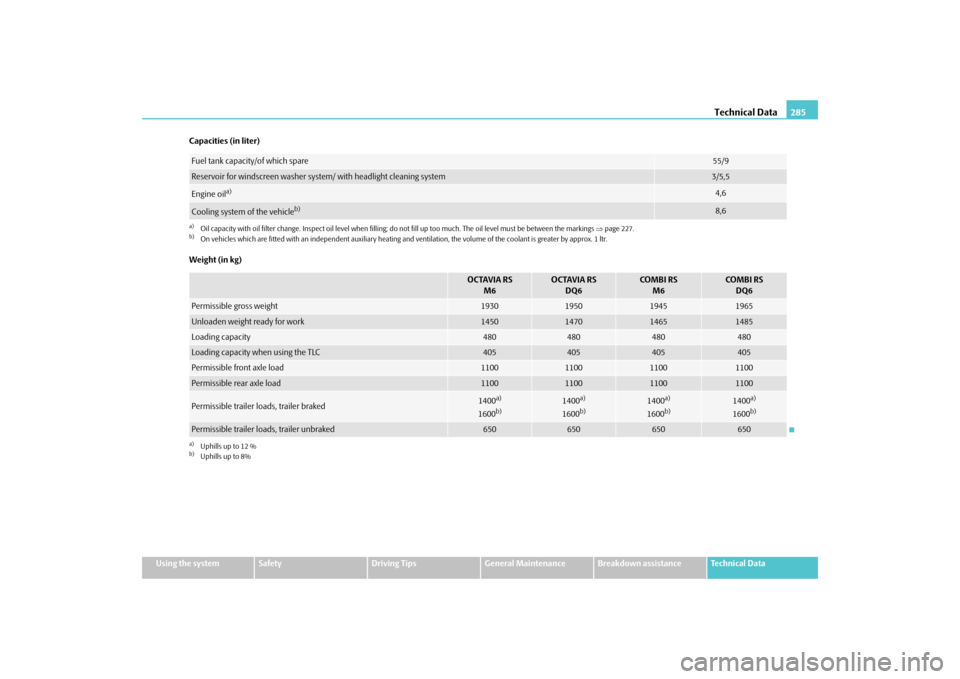
Technical Data
285
Using the system
Safety
Driving Tips
General Maintenance
Breakdown assistance
Technical Data
Capacities (in liter) Weight (in kg)Fuel tank capacity/of which spare
55/9
Reservoir for windscreen washer system/ with headlight cleaning system
3/5,5
Engine oil
a)
a)Oil capacity with oil filter change. Inspect oil level when fi
lling; do not fill up too much. The oil level must be between the
markings
⇒page 227.
4,6
Cooling system of the vehicle
b)
b)On vehicles which are fitted with an indepe
ndent auxiliary heating and ventilation, the
volume of the coolant is greater by app
rox. 1 ltr.
8,6
OCTAVIA RS
M6
OCTAVIA RS
DQ6
COM B I RS
M6
CO M B I R SDQ6
Permissible gross weight
1930
1950
1945
1965
Unloaden weight ready for work
1450
1470
1465
1485
Loading capacity
480
480
480
480
Loading capacity when using the TLC
405
405
405
405
Permissible front axle load
1100
1100
1100
1100
Permissible rear axle load
1100
1100
1100
1100
Permissible trailer loads, trailer braked
1400
a)
1600
b)
a)Uphills up to 12 %b)Uphills up to 8%
1400
a)
1600
b)
1400
a)
1600
b)
1400
a)
1600
b)
Permissible trailer loads, trailer unbraked
650
650
650
650
se0.1.book Page 285 Frida
y, April 10, 2009 3:19 PM
Page 288 of 304
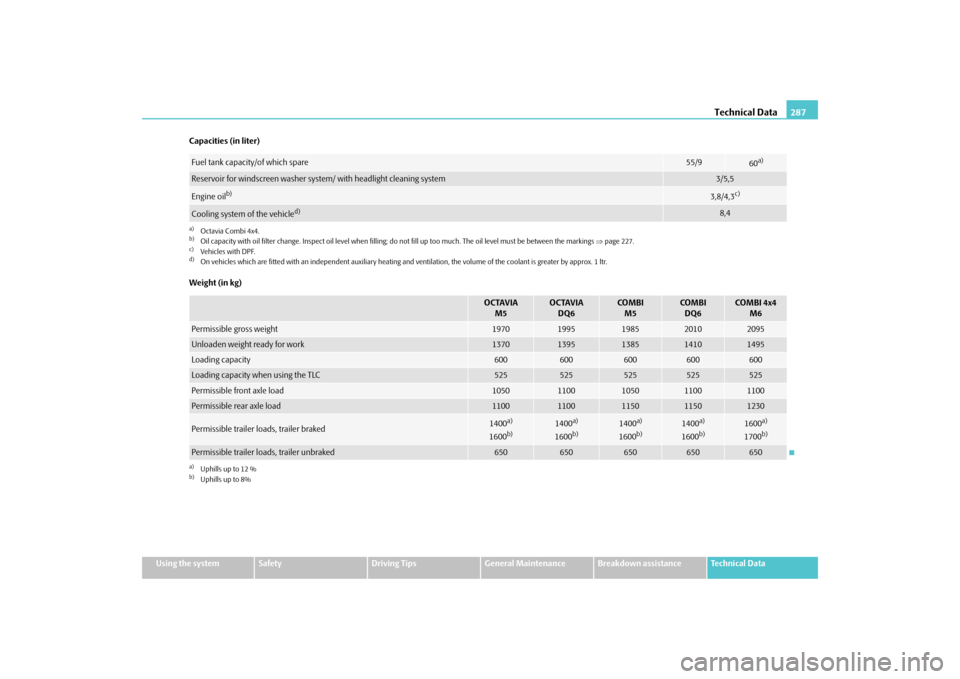
Technical Data
287
Using the system
Safety
Driving Tips
General Maintenance
Breakdown assistance
Technical Data
Capacities (in liter) Weight (in kg)Fuel tank capacity/of which spare
55/9
60a)
a)Octavia Combi 4x4.Reservoir for windscreen washer system/ with headlight cleaning system
3/5,5
Engine oil
b)
b)Oil capacity with oil filter change. Inspect oil level when fi
lling; do not fill up too much. The oil level must be between the
markings
⇒page 227.
3,8/4,3
c)
c)Ve hicles w ith DP F.Cooling system of the vehicle
d)
d)On vehicles which are fitted with an indepe
ndent auxiliary heating and ventilation, the
volume of the coolant is greater by app
rox. 1 ltr.
8,4
OCTAVIA M5
OCTAVIADQ6
COMBIM5
COMBIDQ6
COMBI 4x4
M6
Permissible gross weight
1970
1995
1985
2010
2095
Unloaden weight ready for work
1370
1395
1385
1410
1495
Loading capacity
600
600
600
600
600
Loading capacity when using the TLC
525
525
525
525
525
Permissible front axle load
1050
1100
1050
1100
1100
Permissible rear axle load
1100
1100
1150
1150
1230
Permissible trailer loads, trailer braked
1400
a)
1600
b)
a)Uphills up to 12 %b)Uphills up to 8%
1400
a)
1600
b)
1400
a)
1600
b)
1400
a)
1600
b)
1600
a)
1700
b)
Permissible trailer loads, trailer unbraked
650
650
650
650
650
se0.1.book Page 287 Frida
y, April 10, 2009 3:19 PM